Good News from Saabklubben in Sweden
I started searching for replacement floor sections for the MC850 but wasn’t happy with what I was finding. Then I remembered that Saabklubben of Sweden had a club web store. Turns out that they have floor sections which I have been told are pressed from the original Saab factory dies. The shop didn’t have any way to order and pay for shipment to the USA, but I queried them via email and crossed my fingers. It was a happy day when I got a reply and was told I could order via email and pay through Paypal. The floor and a few other items are ordered and on their way. The photo is from their web store. If you care to look at a few other bits of work I did, please continue reading.About My Welding Skills
As an aside, in case you are wondering about my welding skills (I know I am), I’m total amateur but I’ve learned a lot on mild steel building fiber tumblers for alpaca fleece. That started about 6 years ago when my wife asked if I could build one for her. I designed one, and it worked pretty well with an old dryer motor. Then, I built more and have sold 5 or 6, gradually improving them. It takes too much work to be able to make any money for what I can get for them so I was about to abandon that endeavor, however, I got a call from a woman near Kodiak, Alaska asking about one. I tried to talk her out of it because of the great distance, but she insists she wants one so I am now dividing my MC850 time with a new tumbler project. If you might be wondering, click here to see the fiber tumbler I make and see a panorama of our farm. Just please don’t interrupt my MC850 project any further by asking for one.Engine Floor at Firewall
While waiting for the floor to arrive from Sweden, I am doing additional odds and ends. Up front, where the engine bay floor meets the firewall, I was surprised to find that Saab sprayed undercoating into the V-shaped joining area. I swear, it’s up to an inch thick, and very hard! I’m almost glad that I had to remove the driver-side wheel housing because that made it much more accessible. I found a good wood chisel and hammer were good for chipping it out. You can see in the photo that the passenger side was almost like new with no discernible rust. That made me happy for a change. However, over on the driver side, rust took a heavy toll, but in a small area fortunately. It looks bad but it’s all stuff that I can handle with my limited skills. And fortunately, with the wheel housing off, it’s very accessible.A Patch for the Rear Wheel Housing
At the other end of the car, on the driver-side wheel housing where the rear spring support bar poked through, it is rust-weakened because the hole was never repaired. The donor car wheel housing is solid, so I decided to cut a patch for the weakened area. With some poster board paper, I made a template and marked a cut line as shown in the 2nd photo. I traced the same line on the donor, but marked a cut line 1/2 inch farther out so I can flange the patch and weld it in with overlap. On the outside, the patch will be flush and invisible. The overlap on the inside won’t be visible because it’s down beside the gas tank. After cutting the patch, I held it in place (not flanged yet) just to check its fit. I’ll clean it up well before flanging and welding. I bought a pneumatic, hand-held flanger/hole punch which seems to work very well on 18 gauge steel. This will be a continuous weld so I won’t use the hole punch here, and I’ll have to add a bit of metal to the patch corner which I cut off in error earlier.Sorry I don’t have more progress to show, but I guess that’s the way this project will go, in fits and starts. Hope I haven’t bored anyone with this post.


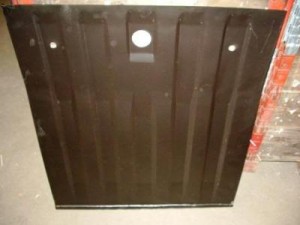
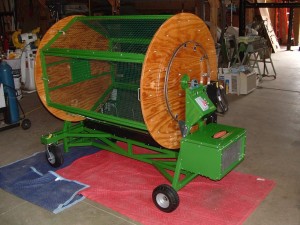
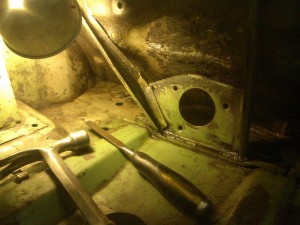

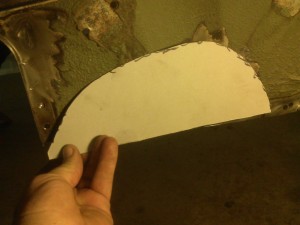
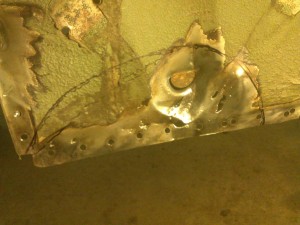
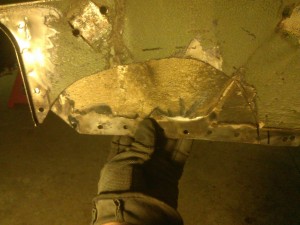
Thanks for sharing & best of luck!
I’m doing a ’65 MC & have ordered parts from the Swede Klub. It is not easy but it’s good to know they are there.
Have you found a source for an interior?
Hi Jim. Sorry for the approval delay. I wish I didn’t have to approve first-time comments like this but the spam exceeds real comments 2 to 1. Anyway, no I don’t have a source for interior needs. I’m holding off until I have a good body just in case I give up on the project. I have a 63 Studebaker Daytona Lark hardtop I was all anxious to restore, but when I got it down to the bare body, I was so dismayed by the rust I set it aside in another barn and switched to the Saab. It’s much better. I do watch eBay and such, but not much else. If you have any tips/advice, I’m all ears.
Nice read. Hope you get the tumbler done quickly, and best of wishes for NOT receiving more tumbler orders….